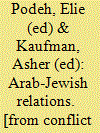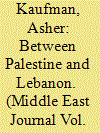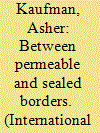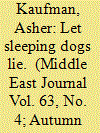|
|
|
Sort Order |
|
|
|
Items / Page
|
|
|
|
|
|
|
| Srl | Item |
| 1 |
ID:
071760


|
|
|
|
|
| Publication |
Portland, Sussex Academic Press, 2006.
|
| Description |
xiv, 386p.hbk
|
| Standard Number |
1903900689
|
|
|
|
|
|
|
|
|
|
|
|
Copies: C:1/I:0,R:0,Q:0
Circulation
| Accession# | Call# | Current Location | Status | Policy | Location |
| 051242 | 956.05/POD 051242 | Main | On Shelf | General | |
|
|
|
|
| 2 |
ID:
147882


|
|
|
|
|
| Summary/Abstract |
This article analyzes spatial perceptions and practices of Druze citizens of Israel before, during, and after the Israeli occupation of South Lebanon in 1982−2000. It argues that the opening of the Israel–Lebanon border in 1982 and its closing in 2000 had three effects: it generated internal social, political, and cultural changes within the community in Israel; it changed the relationship of the Druze with the State of Israel; and it reestablished strong ties with their coreligionists in Lebanon and Syria. Drawing insight from the field of border studies, the article shows how Druze citizens of Israel live concomitantly in state and suprastate spatial scales, forming a third, integrated or hybrid, spatial scale. The article proposes using the concept “hybrid spatial scale” as a tool for studying communities such as the Druze that operate on multiple territorial scales.
|
|
|
|
|
|
|
|
|
|
|
|
|
|
|
|
| 3 |
ID:
074753


|
|
|
|
|
| Publication |
2006.
|
| Summary/Abstract |
This article follows the fate of the only seven Shi'i villages in Mandatory Palestine, beginning in the time of the border demarcation between Palestine and Lebanon (1919-1924) and concluding with Hizbullah's demand to retrieve their territories back to Lebanon (2000). The article examines the relations of the villages with the Jewish Yishuv and with the Sunni population in Palestine during the British Mandate; their fate as Palestinian refugees in Lebanon; and their status in Lebanon after the 1994 naturalization law that granted them Lebanese citizenship. The story of the seven villages is examined through three prisms: that of the villages themselves, of the Palestinians, and of the Lebanese. The different narratives enlighten themes such as the colonial legacy in the Middle East, border dynamics, identity formation, and internal Lebanese politics.
|
|
|
|
|
|
|
|
|
|
|
|
|
|
|
|
| 4 |
ID:
131518


|
|
|
|
|
| Publication |
2014.
|
| Summary/Abstract |
The Trans-Arabian Pipeline (Tapline), which extended from Dhahran in Saudi Arabia to Zahrani in Lebanon and operated from 1950 to 1982, was haunted by the Arab-Israeli conflict throughout the years of its operation. The route of the pipeline-which traversed Saudi Arabia, Jordan, Syria, and Lebanon-was chosen so as to circumvent Palestine/Israel. However, following the Israeli occupation of the Golan Heights in the 1967 war, Israel became an active participant in this project, with the full consent of the transit states and Egypt. This article uses Tapline as a means to analyze the interconnected world facilitated by oil pipelines, which defies common wisdom about state sovereignty or the function of interstate boundaries. In addition, Tapline demonstrates how this interconnected network created possibilities for Arab-Israeli cooperation that might have seemed inconceivable initially, given the hostile dynamics of the conflict.
|
|
|
|
|
|
|
|
|
|
|
|
|
|
|
|
| 5 |
ID:
092176


|
|
|
|
|
| Publication |
2009.
|
| Summary/Abstract |
This article argues that the partition of the village of Ghajar between Israel and Lebanon by the Israeli Line of Withdrawal, as determined by the United Nations in 2000, was based on historical and cartographical errors. It demonstrates that the entire village was controlled by Syria until the June 1967 war when Israel occupied it along with the Golan Heights. The article shows that the entire pre-1967 tri-border region of Syria, Lebanon, and Israel suffered from border irregularities that remained dormant until 2000. Finally, the article argues that Ghajar should remain united, pending a Syrian-Israeli peace deal that theoretically would return the Golan Heights to Syria and include Ghajar in its entirety.
|
|
|
|
|
|
|
|
|
|
|
|
|
|
|
|
|
|
|
|
|